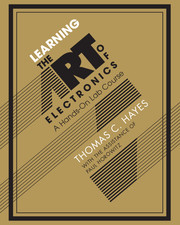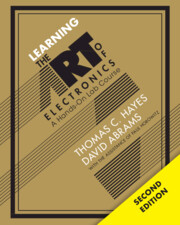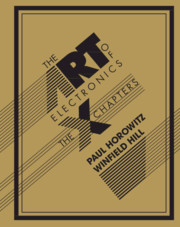Learning the Art of Electronics
This introduction to circuit design is unusual in several respects. First, it offers not just explanations, but a full course. Each of the twenty-five sessions begins with a discussion of a particular sort of circuit followed by the chance to try it out and see how it actually behaves. Accordingly, students understand the circuit's operation in a way that is deeper and much more satisfying than the manipulation of formulas. Second, it describes circuits that more traditional engineering introductions would postpone: on the third day, we build a radio receiver; on the fifth day, we build an operational amplifier from an array of transistors. The digital half of the course centers on applying microcontrollers, but gives exposure to Verilog, a powerful Hardware Description Language. Third, it proceeds at a rapid pace but requires no prior knowledge of electronics. Students gain intuitive understanding through immersion in good circuit design.
- The course is intensive, teaching electronics in day-at-a-time practical doses so that students can learn in a hands-on way
- The integration of discussion of design with a chance to try the circuits means students learn quickly
- The course has been tried and tested, and proven successful through twenty-five years of teaching
- The book is practical: it avoids mathematics and mathematical arguments and even includes a complete list of parts needed in the laboratory exercises, including where and how to buy them
Reviews & endorsements
'Author Thomas Hayes, … designed the new volume for a full-semester laboratory course. [The book] is organised into 26 chapters, each offering rich context and clear explanations in labs, notes, supplementary material and worked problems … labs are balanced between analog and digital electronics. Hayes begins with familiar analog circuitry and includes discussions of voltage dividers, Ohm's and Kirchoffs's laws, and Thevenin equivalents. The labs tackle RC filters in both time and frequency domains with a cheerful approach that is not overly mathematical … retains many of the handsomely drawn circuits of the original Art of Electronics and is much more comprehensive … Instructors will want to know if Learning the Art of Electronics can stand alone as an undergraduate lab text. The answer is yes. While the book does cross-reference The Art of Electronics, it 'means to be self-sufficient', and it achieves that goal.' Paul J. H. Tjossem, Physics Today
'… a well-paced, self-guided course for anyone (who realistically has completed one year of undergraduate studies prior) wanting to get into electronics.' Kymani Armstrong-Williams, https://physicsbookreviewer.blogspot.com
Product details
No date availablePaperback
9780521177238
1150 pages
255 × 204 × 41 mm
2.13kg
180 b/w illus. 20 tables
Table of Contents
- 1. DC circuits
- 2. RC circuits
- 3. Diode circuits
- 4. Transistors I
- 5. Transistors II
- 6. Operational amplifiers I
- 7. Operational amplifiers II: nice positive feedback
- 8. Operational amplifiers III
- 9. Operational amplifiers IV: nasty positive feedback
- 10. Operational amplifiers V: PID motor control loop
- 11. Voltage regulators
- 12. MOSFET switches
- 13. Group audio project
- 14. Logic gates
- 15. Logic compilers, sequential circuits, flip-flops
- 16. Counters
- 17. Memory: state machines
- 18. Analog to digital: phase-locked loop
- 19. Microcontrollers and microprocessors I: processor/controller
- 20. I/O, first assembly language
- 21. Bit operations
- 22. Interrupt: ADC and DAC
- 23. Moving pointers, serial buses
- 24. Dallas Standalone Micro, SiLabs SPI RAM
- 25. Toys in the attic
- Appendices
- Index.





